This was published 9 years ago
What you need to know about the European refugee crisis
Why doesn't Europe just do what Australia did? Europe is not an island, for starters.
By Nick Miller
- What is the EU actually for?
- A death notice for Aylan
- How you can help the refugees
- Britain to take more refugees
- Migrant crisis: full coverage
How big is the refugee problem on Europe's borders?
Big. Really big.
Robert Visser, director of the European Asylum Support Office, says conflict creates refugees, and there is more conflict near Europe's borders than there used to be. He points to Ukraine, the Middle East, Syria, Iraq, Afghanistan, the Horn of Africa.
"This produces people who go on the move and seek their future in Europe," he says.
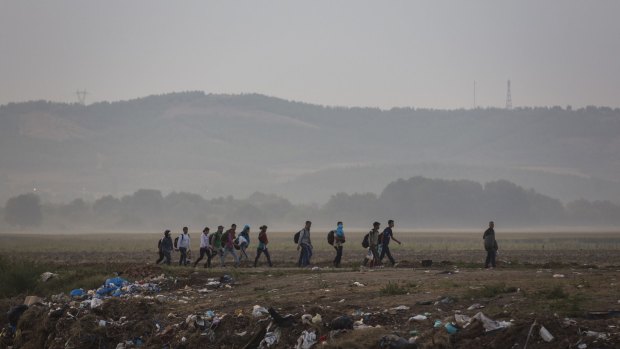
Fleeing catastrophe: Australia could and should take many more Syrian refugees of all backgrounds.Credit: AP
The International Organisation for Migration estimates that more than 350,000 migrants were detected at the EU's borders between January and August this year. And there is potential for this number to keep climbing.
Violence and civil war in Syria and Iraq have displaced millions. An estimated 1.7 million refugees are in Turkey, 1.2 million in Lebanon, more than 600,000 in Jordan, hundreds of thousands in Iraq and Egypt. Another 7 million are internally displaced inside Syria. Roughly half of the country's entire pre-war population are refugees, at home or abroad.
On top of this, estimates of the numbers of people fleeing sub-Saharan Africa range up to another million – many of these end up in Libya or Tunisia, waiting to cross the Mediterranean.
How many are crossing into Europe?

A young Syrian boy cries as his father carries him up a steep hill as they walk to a crossing on the Greek border with Macedonia.Credit: Getty
The flow of asylum seekers into Europe is increasing.
According to Eurostat, 662,000 people applied for asylum in the EU in 2014. This was almost 200,000 more than the year before, and double the number in 2011.
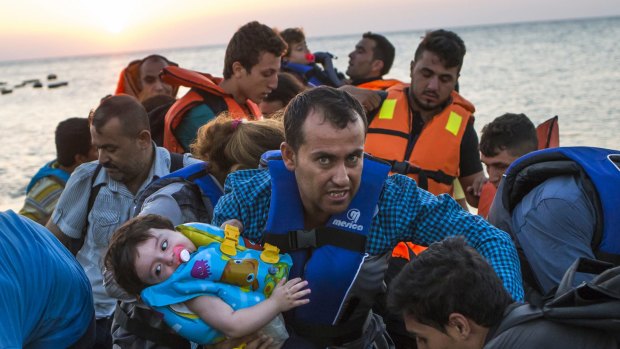
A man carries a girl in his arm as they arrive with other migrants just after dawn on a dinghy after crossing from Turkey to the island of Kos in southeastern Greece.Credit: AP
The number is going to be even higher this year. Already it is about half a million, tracking 100-150,000 greater than the same time last year, an EU official told Fairfax Media.
Before June this year, between 60,000 and 70,000 new applications were coming in every month. In June the number suddenly shot up to 88,000.
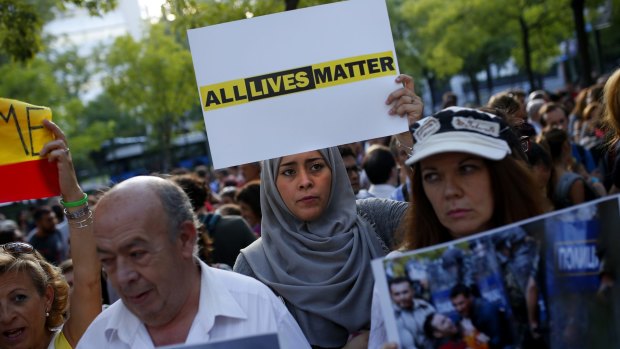
People gather outside the European Commission headquarters in support of people seeking to enter Europe.Credit: AP
Who are they?
In terms of origin, since 2012 by far the biggest national group has been those fleeing Syria. In 2014 Syrians made up 128,000 of the total asylum applicants – followed by 47,000 from Eritrea, 43,000 from Afghanistan, 38,000 from Kosovo, 31,000 from Serbia, then Pakistan, Iraq and Nigeria.
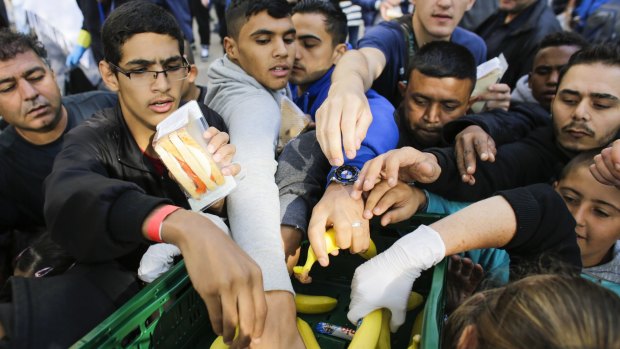
Migrants grab for food at a reception centre for refugees and asylum seekers in Berlin.Credit: AP
But the picture was different in 2010 – back then, the biggest group were Afghans, followed by Russians, Serbs and Iraqis.
Are they all allowed to stay?
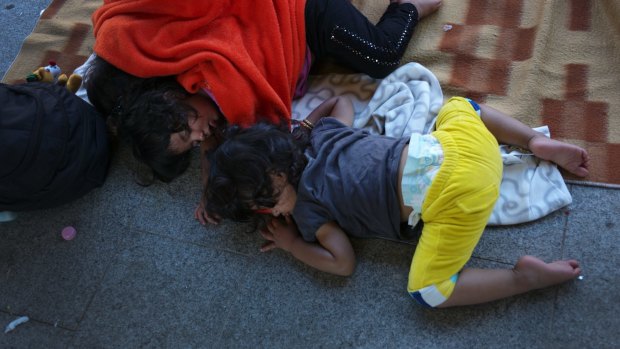
Refugee children sleep on the outdoor floor of the Keleti railway station in Budapest, Hungary.Credit: AP
Of course, not all asylum applications are approved. By Visser's estimate, up to a third of those seeking asylum in Europe do not qualify as refugees – at least by the standards that Europe applies.
There is political debate over those standards. Some say that migrants fleeing abject poverty, mandatory conscription or major civil unrest should be treated as refugees. Others say Europe is being too lenient, treating many as refugees who are really just seeking a better life in a better country, with better options for employment.
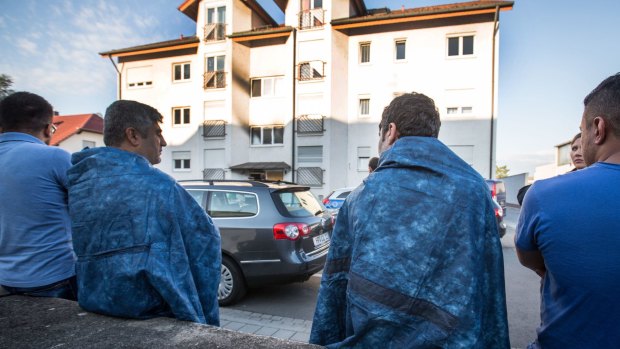
Residents sit in front of an accommodation for asylum seekers in Heppenheim, Germany.Credit: AP
How do they get into Europe?
According to Frontex figures, in 2014 the majority of the refugees came over the central Mediterranean, on boats from Libya and Tunisia.
But this year the numbers coming by that route have almost halved – instead, there has been a huge surge in people coming over the eastern Mediterranean, at the land border between Greece and Turkey, or more usually over the sea. They make the short hop to islands such as Lesbos or Kos, where the arrival of so many unexpected asylum seekers has overwhelmed local authorities' ability to house, clothe, feed and process them. Many even travel by the regular passenger ferries: Greece claims that Turkish officials were making no attempt to stop them boarding.
Finally, there has also been a huge leap – more than doubling – in the numbers coming from or through the (non-EU) Balkan states such as Serbia, moving north to the borders with Austria and Hungary.
Where do they hope to go?
The short answer is, somewhere better.
Refugees themselves differ. I have spoken to some determined to reach Britain, others who say Britain is "very bad", citing its chequered history in the Middle East. Others talked of Canada, or Sweden.
Many want to go to Germany, because they know it is the most welcoming country, one where they stand the best chance of finding a community, starting a new life, getting a job, rather than ending up in a stagnant southern Europe economy or an eastern Europe camp in an unsympathetic, poor region. On Saturday, Austria said the asylum seekers would be granted entry, regardless of European Union rules.
Often, language is the determining factor. Those from Africa, especially, have English as a second language. They want education and employment, and ending up in an English-speaking country would make it easier to integrate faster.
How is the EU managing this?
The EU's "Dublin" regulations require that an asylum seeker is processed, their claim assessed, in the first country where they touch European soil.
After that, if their application is successful, they are resettled to countries that volunteer to take them.
This system is just not working.
The number of pending asylum applications rises every month. In September last year 434,000 people were in limbo, waiting to hear whether their application would be approved. By January it was 506,000. In June, the most recent month covered by Eurostat's figures, it was up to 568,000.
After processing only a handful of countries take almost all the refugees – Germany and Sweden welcome almost half, with France, Italy, Switzerland and Britain taking most of the rest.
This system operates in addition to the "resettlement" system: countries taking refugees directly from the camps on Syria's borders.
Countries (including Australia) take thousands each year under this scheme, with refugees assessed in terms of risk, urgency and medical need.
Why doesn't Europe just do what Australia did?
Indeed, some people are suggesting just that – UKIP's Nigel Farage, and Tony Abbott, for example.
There are two main reasons why it's more complicated for Europe.
Firstly, clearly, Europe is not an island. There are many overland routes to Europe – some refugees are even appearing in Scandinavia. Last week, a 31-year-old Syrian asylum seeker found refuge in Oslo after riding a bicycle across Russia's Arctic border with Norway.
Australia has, so far, not needed a "turn back the bicycles" policy.
Countless roads criss-cross the borders, and they're busy with modern commerce. It would take an extraordinary investment in infrastructure and personnel to close and secure the thousands of kilometres of Europe's land border.
Europe has tried artificial barriers, but Hungary's hastily-erected razor wire is failing to deter many. Wire can be cut. Tunnels can be dug.
A sea is a natural barrier. But the sea routes to Europe are much kinder than those to Australia. In the summer, the Mediterranean is often a bathtub dotted with cavorting dolphins. From the Greek island of Kos, the twinkling lights of Bodrum in Turkey are just a few hours' paddle in a dinghy away, for the determined. Obviously, the dangers are still there, especially as people smugglers and refugees resort to tiny, overloaded boats not fit for the voyage. But it must feel like a much less daunting option than the voyage to Christmas Island would. Turning back every boat on the wide Mediterranean would be a huge, massively expensive naval exercise.
Also, if a refugee has come via Libya, their boat would be turned back to a lawless, violent, near-failed state. It's no Indonesia.
What about public sentiment?
Even if it were practical to adopt a more "brutal" (in the words of the New York Times) refugee policy for Europe, there is neither the political nor public will. Europeans differ on the details (especially in the east) but many countries, especially influential Germany, feel a strong moral imperative to help those fleeing conflict at the first instance, rather than reject them unless they apply through the slow, congested official channels.
The shocking photo last week of the dead three-year-old Syrian boy on the Turkish beach has largely inspired compassion and a push to welcome more refugees, rather than to try to deter them from coming.
Where to from here?
Next week, European Commission president Jean-Claude Juncker is expected to unveil a plan for relocating 120,000 more refugees. But this is just a stopgap.
In the long term, the EU needs a continent-wide solution.
European states are bickering over how to spread the load more evenly. The aim is firstly to take some of the pressure off the countries where migrants arrive (such as Italy, Greece and Hungary), by sharing the processing duties on asylum applications.
Then, Germany and Sweden want a mandatory quota system for settling refugees, sharing them out over the continent.
Neither the refugees themselves, nor some of the countries more antipathetic to migrants, are happy with that idea.
So far, there doesn't seem to be a consensus.